《植物育种学》课程教学大纲(作物育种学教学大纲,中英文)
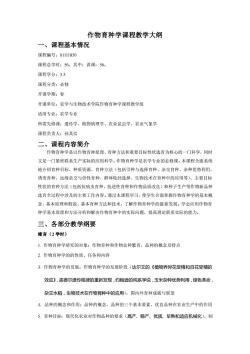
作物育种学课程教学大纲一、课程基本情况课程编号:01111850课程总学时:56,其中:讲课:56。课程学分:3.5课程分类:必修开课学期:春开课单位:农学与生物技术学院作物育种学课程教学组适用专业:农学专业所需先修课:遗传学、植物病理学、农业昆虫学、农业气象学课程负责人:孙其信二、课程内容简介作物育种学是以作物育种原理、育种方法和重要目标性状选育为核心的一门科学,同时义是一门紧密联系生产实际的应用科学。作物育种学是农学专业的必修课。本课程全面系统地介绍育种目标、种质资源、育种方法(包括引种与选择育种、杂交育种、杂种优势利用、诱变育种、远缘杂交与倍性育种、群体轮回选择、生物技术在育种中的应用等)、主要目标性状的育种方法(包括抗病虫育种、抗逆性育种和作物品质改良)和种子生产等作物新品种选育全过程中涉及的主要工作内容。通过本课程学习,使学生合面掌握作物育种学的基本概念、基本原理和假说、基本育种方法和技术,了解作物育种学的最新发展。学会应用作物育种学基本原理和方法分析和解决作物育种中的实际问题,提高理论联系实际的能力。三、各部分教学纲要绪言(2学时)1.作物育种学研究的对象:作物育种和作物良种繁育,品种的概念及特点2.作物育种学的的性质、任务和内容3.作物育种学的发展:作物育种学的发展阶段(达尔文的《植物界异花受精和自花受精的效应》,孟德尔遗传规律的重新发现,约翰逊的纯系学说,玉米杂种优势利用,绿色革命,杂交水稻,生物技术在作物育种中的应用),国内外育种成就与展望4.品种的概念和作用:品种的概念,品种的三个基本要素,优良品种在农业生产中的作用5.育种目标:现代化农业对作物品种的要求(高产、稳产、优质、早熟和适应机械化),制
作物育种学课程教学大纲 一、课程基本情况 课程编号:01111850 课程总学时:56,其中:讲课:56。 课程学分:3.5 课程分类:必修 开课学期:春 开课单位:农学与生物技术学院作物育种学课程教学组 适用专业:农学专业 所需先修课:遗传学、植物病理学、农业昆虫学、农业气象学 课程负责人:孙其信 二、课程内容简介 作物育种学是以作物育种原理、育种方法和重要目标性状选育为核心的一门科学,同时 又是一门紧密联系生产实际的应用科学。作物育种学是农学专业的必修课。本课程全面系统 地介绍育种目标、种质资源、育种方法(包括引种与选择育种、杂交育种、杂种优势利用、 诱变育种、远缘杂交与倍性育种、群体轮回选择、生物技术在育种中的应用等)、主要目标 性状的育种方法(包括抗病虫育种、抗逆性育种和作物品质改良)和种子生产等作物新品种 选育全过程中涉及的主要工作内容。通过本课程学习,使学生合面掌握作物育种学的基本概 念、基本原理和假说、基本育种方法和技术,了解作物育种学的最新发展。学会应用作物育 种学基本原理和方法分析和解决作物育种中的实际问题,提高理论联系实际的能力。 三、各部分教学纲要 绪言(2 学时) 1. 作物育种学研究的对象:作物育种和作物良种繁育,品种的概念及特点 2. 作物育种学的的性质、任务和内容 3. 作物育种学的发展:作物育种学的发展阶段(达尔文的《植物界异花受精和自花受精的 效应》,孟德尔遗传规律的重新发现,约翰逊的纯系学说,玉米杂种优势利用,绿色革命, 杂交水稻,生物技术在作物育种中的应用),国内外育种成就与展望 4. 品种的概念和作用:品种的概念,品种的三个基本要素,优良品种在农业生产中的作用 5. 育种目标:现代化农业对作物品种的要求(高产、稳产、优质、早熟和适应机械化),制
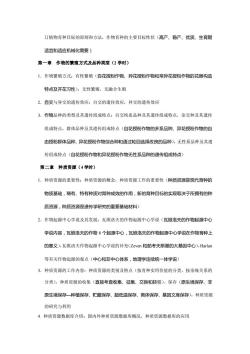
订植物育种目标的原则和方法,作物育种的主要目标性状(高产、稳产、优质、生育期适宜和适应机械化需要)第一章作物的繁殖方式及品种类型(2学时)1.作物繁殖方式:有性繁殖(自花授粉作物、异花授粉作物和常异花授粉作物的花器构造特点及开花习性),无性繁殖,无融合生殖2.自交与异交的遗传效应:自交的遗传效应,异交的遗传效应3.作物品种的类型及其遗传组成特点:自交纯系品种及其遗传组成特点,杂交种及其遗传组成特点,群体品种及其遗传组成特点(自花授粉作物的多系品种、异花授粉作物的自由授粉群体品种、异花授粉作物综合种和通过轮回选择改良的品种),无性系品种及其遗传组成特点(自花授粉作物和异花授粉作物无性系品种的遗传组成特点)第二章种质资源(4学时)1.种质资源的重要性:种质资源的概念,种质资源工作的重要性(种质资源是现代育种的物质基础,稀有、特有种质对育种成效的作用,新的育种目标的实现取决于所拥有的种质资源,种质资源是遗传学研究的重要基础材料2.作物起源中心学说及其发展:瓦维洛夫的作物起源中心学说(瓦维洛夫的作物起源中心学说内容,瓦维洛夫的作物8个起源中心,瓦维洛夫的作物起源中心学说在作物育种上的意义),瓦维洛夫作物起源中心学说的补充(Zeven和茹考夫斯基的大基因中心),Harlan等有关作物起源的观点(中心和非中心体系,地理学连续统一体学说)3.种质资源的工作内容:种质资源的类别及特点(按育种实用价值的分类,按亲缘关系的分类),种质资源的收集(直接考查收集、征集、交换和转引)、保存(原生境保存、非原生境保存一种植保存、贮藏保存、超低温保存、离体保存、基因文库保存),种质资源的研究与利用4.种质资源数据库介绍:国内外种质资源数据库概况,种质资源数据库的应用
订植物育种目标的原则和方法,作物育种的主要目标性状(高产、稳产、优质、生育期 适宜和适应机械化需要) 第一章 作物的繁殖方式及品种类型(2 学时) 1.作物繁殖方式:有性繁殖(自花授粉作物、异花授粉作物和常异花授粉作物的花器构造 特点及开花习性),无性繁殖,无融合生殖 2.自交与异交的遗传效应:自交的遗传效应,异交的遗传效应 3.作物品种的类型及其遗传组成特点:自交纯系品种及其遗传组成特点,杂交种及其遗传 组成特点,群体品种及其遗传组成特点(自花授粉作物的多系品种、异花授粉作物的自 由授粉群体品种、异花授粉作物综合种和通过轮回选择改良的品种),无性系品种及其遗 传组成特点(自花授粉作物和异花授粉作物无性系品种的遗传组成特点) 第二章 种质资源(4 学时) 1.种质资源的重要性:种质资源的概念,种质资源工作的重要性(种质资源是现代育种的 物质基础,稀有、特有种质对育种成效的作用,新的育种目标的实现取决于所拥有的种 质资源,种质资源是遗传学研究的重要基础材料) 2.作物起源中心学说及其发展:瓦维洛夫的作物起源中心学说(瓦维洛夫的作物起源中心 学说内容,瓦维洛夫的作物 8 个起源中心,瓦维洛夫的作物起源中心学说在作物育种上 的意义),瓦维洛夫作物起源中心学说的补充(Zeven 和茹考夫斯基的大基因中心),Harlan 等有关作物起源的观点(中心和非中心体系,地理学连续统一体学说) 3.种质资源的工作内容:种质资源的类别及特点(按育种实用价值的分类,按亲缘关系的 分类),种质资源的收集(直接考查收集、征集、交换和转引)、保存(原生境保存、非 原生境保存—种植保存、贮藏保存、超低温保存、离体保存、基因文库保存),种质资源 的研究与利用 4. 种质资源数据库介绍:国内外种质资源数据库概况,种质资源数据库的应用
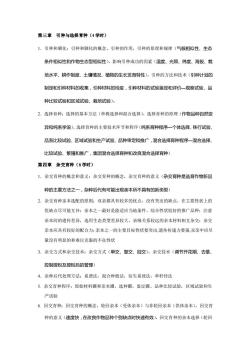
第三章引种与选择育种(4学时)1.引种和化:引种和驯化的概念,引种的作用,引种的原理和规律(气候相似性、生态条件相似性和作物生态型相似性),影响引种成功的因素(温度、光照、纬度、海拔、栽培水平、耕作制度、土壤情况、植物的生长发育特性),引种的方法和技术(引种计划的制定和引种材料的收集,引种材料的检疫,引种材料的试验鉴定和评价一观察试验、品种比较试验和区域试验、栽培试验)。2.选择育种:选择的基本方法(单株选择和混合选择),选择育种的原理(作物品种自然变异和纯系学说),选择育种的主要技术环节和程序(纯系育种程序一个体选择、株行试验、品系比较试验、区域试验和生产试验、品种审定和推广,混合选择育种程序一混合选择比较试验、繁殖和推广,集团混合选择育种和改良混合选择育种)第四章杂交育种(8学时)1.杂交育种的概念和意义:杂交育种的概念,杂交育种的意义(杂交育种是选育作物新品种的主要方法之一,杂种后代有可能出现亲本所不具有的新类型)2.杂交育种亲本选配的原则:双亲都具有较多的优点,没有突出的缺点,在主要性状上的优缺点尽可能互补:亲本之一最好是能适应当地条件、综合性状较好的推广品种:注意亲本间的遗传差异,选用生态类型差异较大,亲缘关系较远的亲本材料相互杂交:杂交亲本应具有较好的配合力:亲本之一的主要目标性状要突出,遗传传递力要强,双亲中应尽量没有明显的和难以克服的不良性状3.杂交方式和杂交技术:杂交方式(单交、复交、回交),杂交技术(调节开花期、去雄、控制授粉及授粉后的管理4.杂种后代处理方法:系谱法,混合种植法,衍生系统法,单籽传法5.杂交育种程序:原始材料圃和亲本圃,选种圃,鉴定圃,品种比较试验,区域试验和生产试验6.回交育种:回交育种的概念,轮回亲本(受体亲本)与非轮回亲本(供体亲本),回交育种的意义(速度快,在改良作物品种个别缺点时快速有效),回交育种的亲本选择(轮回
第三章 引种与选择育种(4 学时) 1.引种和驯化:引种和驯化的概念,引种的作用,引种的原理和规律(气候相似性、生态 条件相似性和作物生态型相似性),影响引种成功的因素(温度、光照、纬度、海拔、栽 培水平、耕作制度、土壤情况、植物的生长发育特性),引种的方法和技术(引种计划的 制定和引种材料的收集,引种材料的检疫,引种材料的试验鉴定和评价—观察试验、品 种比较试验和区域试验、栽培试验)。 2.选择育种:选择的基本方法(单株选择和混合选择),选择育种的原理(作物品种自然变 异和纯系学说),选择育种的主要技术环节和程序(纯系育种程序—个体选择、株行试验、 品系比较试验、区域试验和生产试验、品种审定和推广,混合选择育种程序—混合选择、 比较试验、繁殖和推广,集团混合选择育种和改良混合选择育种) 第四章 杂交育种(8 学时) 1.杂交育种的概念和意义:杂交育种的概念,杂交育种的意义(杂交育种是选育作物新品 种的主要方法之一,杂种后代有可能出现亲本所不具有的新类型) 2.杂交育种亲本选配的原则:双亲都具有较多的优点,没有突出的缺点,在主要性状上的 优缺点尽可能互补;亲本之一最好是能适应当地条件、综合性状较好的推广品种;注意 亲本间的遗传差异,选用生态类型差异较大,亲缘关系较远的亲本材料相互杂交;杂交 亲本应具有较好的配合力;亲本之一的主要目标性状要突出,遗传传递力要强,双亲中应尽 量没有明显的和难以克服的不良性状 3.杂交方式和杂交技术:杂交方式(单交、复交、回交),杂交技术(调节开花期、去雄、 控制授粉及授粉后的管理) 4.杂种后代处理方法:系谱法,混合种植法,衍生系统法,单籽传法 5. 杂交育种程序:原始材料圃和亲本圃,选种圃,鉴定圃,品种比较试验,区域试验和生 产试验 6. 回交育种:回交育种的概念,轮回亲本(受体亲本)与非轮回亲本(供体亲本),回交育 种的意义(速度快,在改良作物品种个别缺点时快速有效),回交育种的亲本选择(轮回
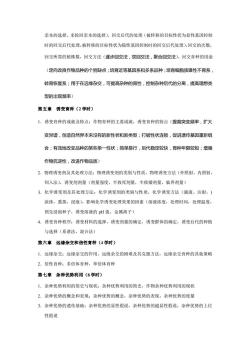
亲本的选择,非轮回亲本的选择),回交后代的处理(被转移的目标性状为显性基因控制时的回交后代处理,被转移的目标性状为隐性基因控制时的回交后代处理),回交的次数回交所需的植株数,回交方法(逐步回交法,双回交法,聚合回交法),回交育种的用途(定向改良作物品种的个别缺点;培育近等基因系和多系品种;培育细胞质雄性不育系,转育恢复系;用于在远缘杂交,可提高杂种的育性,控制杂种后代的分离,提高理想类型的出现频率)第五章诱变育种(2学时)1.诱变育种的成就及特点:作物育种的主要成就,诱变育种的特点(提高突变频率,扩大变异谱,创造自然界本来没有的新性状和新类型;打破性状连锁,促进遗传基因重新组合;有效地改变品种的某些单一性状;简单易行,后代稳定较快,育种年限较短;增强作物抗逆性,改进作物品质)2.物理诱变剂及其处理方法:物理诱变剂的类别与性质,物理诱变方法(外照射,内照射,饲入法),诱变剂剂量(剂量强度,半致死剂量,半致矮剂量,临界剂量)3.化学诱变剂及其处理方法:化学诱变剂的类别与性质,化学诱变方法(滴液,注射,)涂抹,熏蒸,浸泡),影响化学诱变处理效果的因素(溶液浓度,处理时间,处理温度预先浸泡种子,诱变溶液的pH值,金属离子4.诱变育种程序:诱变材料的选择,诱变剂量的确定,诱变群体的确定,诱变后代的种植与选择(系谱法,混合法)第六章远缘杂交和倍性育种(4学时)1.远缘杂交:远缘杂交的作用,远缘杂交的困难及其克服方法,远缘杂交育种的其他策略2.倍性育种:多倍体育种,单倍体育种第七章杂种优势利用(8学时)1.杂种优势利用的简史与现状:杂种优势利用的简史,作物杂种优势利用的现状2.杂种优势的概念和表现:杂种优势的概念,杂种优势的表现,杂种优势的度量3.杂种优势的遗传基础:杂种优势的显性假说,杂种优势的超显性假说,杂种优势的上位性假说
亲本的选择,非轮回亲本的选择),回交后代的处理(被转移的目标性状为显性基因控制 时的回交后代处理,被转移的目标性状为隐性基因控制时的回交后代处理),回交的次数, 回交所需的植株数,回交方法(逐步回交法,双回交法,聚合回交法),回交育种的用途 (定向改良作物品种的个别缺点;培育近等基因系和多系品种;培育细胞质雄性不育系, 转育恢复系;用于在远缘杂交,可提高杂种的育性,控制杂种后代的分离,提高理想类 型的出现频率) 第五章 诱变育种(2 学时) 1.诱变育种的成就及特点:作物育种的主要成就,诱变育种的特点(提高突变频率,扩大 变异谱,创造自然界本来没有的新性状和新类型;打破性状连锁,促进遗传基因重新组 合;有效地改变品种的某些单一性状;简单易行,后代稳定较快,育种年限较短;增强 作物抗逆性,改进作物品质) 2.物理诱变剂及其处理方法:物理诱变剂的类别与性质,物理诱变方法(外照射,内照射, 饲入法),诱变剂剂量(剂量强度,半致死剂量,半致矮剂量,临界剂量) 3.化学诱变剂及其处理方法:化学诱变剂的类别与性质,化学诱变方法(滴液,注射,) 涂抹,熏蒸,浸泡),影响化学诱变处理效果的因素(溶液浓度,处理时间,处理温度, 预先浸泡种子,诱变溶液的 pH 值,金属离子) 4.诱变育种程序:诱变材料的选择,诱变剂量的确定,诱变群体的确定,诱变后代的种植 与选择(系谱法,混合法) 第六章 远缘杂交和倍性育种(4 学时) 1.远缘杂交:远缘杂交的作用,远缘杂交的困难及其克服方法,远缘杂交育种的其他策略 2.倍性育种:多倍体育种,单倍体育种 第七章 杂种优势利用(8 学时) 1.杂种优势利用的简史与现状:杂种优势利用的简史,作物杂种优势利用的现状 2.杂种优势的概念和表现:杂种优势的概念,杂种优势的表现,杂种优势的度量 3.杂种优势的遗传基础:杂种优势的显性假说,杂种优势的超显性假说,杂种优势的上位 性假说
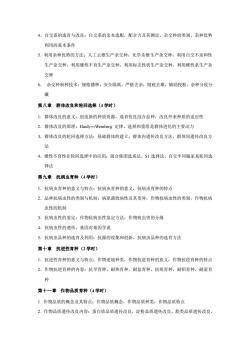
4.自交系的选育与改良:自交系的亲本选配,配合力及其测定,杂交种的类别,杂种优势利用的基本条件5.利用杂种优势的方法:人工去雄生产杂交种,化学杀雄生产杂交种,利用自交不亲和性生产杂交种,利用雄性不育生产杂交种,利用标志性状生产杂交种,利用雌性系生产杂交种6.杂交种制种技术:规格播种,安全隔离,严格去杂,彻底去雄,辅助授粉,杂种分收分藏第八章群体改良和轮回选择(4学时)1.群体改良的意义:创造新的种质资源,选育优良综合品种,改良外来种质的适应性2.群体改良的原理:Hardy一Weinberg定律,选择和重组是群体进化的主要动力3.群体改良的轮回选择方法:基础群体的建立,群体内遗传改良方法,群体间遗传改良方法4.雄性不育性在轮回选择中的应用:混合集团选系法,S1选择法,自交半同胞家系轮回选择法第九章抗病虫育种(4学时)1.抗病虫育种的意义与特点:抗病虫育种的意义,抗病虫育种的特点2.品种抗病虫性的类别与机制:病原菌致病性及其变异,作物抗病虫性的类别,作物抗病虫性的机制3.抗病虫性的鉴定:作物抗病虫性鉴定方法,作物病虫害的分级4.抗病虫性的遗传,基因对基因学说5.抗病虫品种的选育及利用:抗源的收集和创新,抗病虫品种的选育方法第十章抗逆性育种(2学时)1.抗逆性育种的意义与特点:作物逆境种类,作物抗逆育种的意义,作物抗逆育种的特点2.作物抗逆育种的内容:抗旱育种,耐热育种,耐盐育种,抗寒育种,耐铝育种,耐湿育种第十一章作物品质育种(4学时)1.作物品质的概念及其特点:作物品质概念,作物品质种类,作物品质特点2.作物品质遗传改良内容:蛋白质品质遗传改良,淀粉品质遗传改良,脂类品质遗传改良
4.自交系的选育与改良:自交系的亲本选配,配合力及其测定,杂交种的类别,杂种优势 利用的基本条件 5. 利用杂种优势的方法:人工去雄生产杂交种,化学杀雄生产杂交种,利用自交不亲和性 生产杂交种,利用雄性不育生产杂交种,利用标志性状生产杂交种,利用雌性系生产杂 交种 6. 杂交种制种技术:规格播种,安全隔离,严格去杂,彻底去雄,辅助授粉,杂种分收分 藏 第八章 群体改良和轮回选择(4 学时) 1.群体改良的意义:创造新的种质资源,选育优良综合品种,改良外来种质的适应性 2.群体改良的原理:Hardy—Weinberg 定律,选择和重组是群体进化的主要动力 3.群体改良的轮回选择方法:基础群体的建立,群体内遗传改良方法,群体间遗传改良方 法 4.雄性不育性在轮回选择中的应用:混合集团选系法,S1 选择法,自交半同胞家系轮回选 择法 第九章 抗病虫育种(4 学时) 1.抗病虫育种的意义与特点:抗病虫育种的意义,抗病虫育种的特点 2.品种抗病虫性的类别与机制:病原菌致病性及其变异,作物抗病虫性的类别,作物抗病 虫性的机制 3.抗病虫性的鉴定:作物抗病虫性鉴定方法,作物病虫害的分级 4.抗病虫性的遗传,基因对基因学说 5.抗病虫品种的选育及利用:抗源的收集和创新,抗病虫品种的选育方法 第十章 抗逆性育种(2 学时) 1.抗逆性育种的意义与特点:作物逆境种类,作物抗逆育种的意义,作物抗逆育种的特点 2.作物抗逆育种的内容:抗旱育种,耐热育种,耐盐育种,抗寒育种,耐铝育种,耐湿育 种 第十一章 作物品质育种(4 学时) 1. 作物品质的概念及其特点:作物品质概念,作物品质种类,作物品质特点 2. 作物品质遗传改良内容:蛋白质品质遗传改良,淀粉品质遗传改良,脂类品质遗传改良
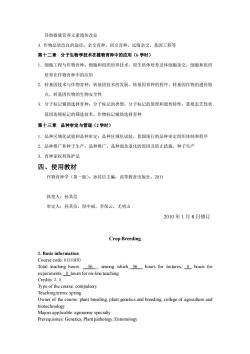
其他微量营养元素遗传改良3.作物品质改良的途径:杂交育种,回交育种,远缘杂交,基因工程等第十二章分子生物学技术在植物育种中的应用(6学时)1.细胞工程与作物育种:细胞和组织培养技术,原生质体培养及体细胞杂交,细胞和组织培养在作物育种中的应用2.转基因技术与作物育种:转基因技术的发展,转基因育种的程序,转基因作物的遗传特点,转基因作物的生物安全性3.分子标记辅助选择育种:分子标记的类型,分子标记的原理和遗传特性,重要农艺性状基因连锁标记的筛选技术,作物标记辅助选择育种第十三章品种审定与管理(2学时)1.品种区域化试验和品种审定:品种区域化试验,我国现行的品种审定组织体制和程序2.品种推广和种子生产:品种推广,品种混杂退化的原因及防止措施,种子生产3.育种家权利保护法四、使用教材作物育种学(第一版),孙其信主编,高等教育出版社,2011执笔人:孙其信审定人:孙其信,倪中福,李保云,尤明山2010年1月8日修订Crop Breeding1. Basic informationCourse code:01111850Total teaching hours:56,among which56hours for lectures,0_hours foiexperiments,_0_hours for on-line teachingCredits: 3.5Type of the course:compulsoryTeachingterms:springOwner of the course: plant breeding, plant genetics and breeding, college of agriculture andbiotechnologyMajors applicable: agronomy specialtyPrerequisites:Genetics,Plantpathology,Entomology
其他微量营养元素遗传改良 3. 作物品质改良的途径:杂交育种,回交育种,远缘杂交,基因工程等 第十二章 分子生物学技术在植物育种中的应用(6 学时) 1.细胞工程与作物育种:细胞和组织培养技术,原生质体培养及体细胞杂交,细胞和组织 培养在作物育种中的应用 2.转基因技术与作物育种:转基因技术的发展,转基因育种的程序,转基因作物的遗传特 点,转基因作物的生物安全性 3.分子标记辅助选择育种:分子标记的类型,分子标记的原理和遗传特性,重要农艺性状 基因连锁标记的筛选技术,作物标记辅助选择育种 第十三章 品种审定与管理(2 学时) 1.品种区域化试验和品种审定:品种区域化试验,我国现行的品种审定组织体制和程序 2.品种推广和种子生产:品种推广,品种混杂退化的原因及防止措施,种子生产 3.育种家权利保护法 四、使用教材 作物育种学(第一版),孙其信主编,高等教育出版社,2011 执笔人:孙其信 审定人:孙其信,倪中福,李保云,尤明山 2010 年 1 月 8 日修订 Crop Breeding 1. Basic information Course code: 01111850 Total teaching hours: _ 56 _, among which_56 _ hours for lectures, _0_ hours for experiments, _0_hours for on-line teaching. Credits: 3.5 Type of the course: compulsory Teaching terms: spring Owner of the course: plant breeding, plant genetics and breeding, college of agriculture and biotechnology Majors applicable: agronomy specialty Prerequisites: Genetics, Plant pathology, Entomology

Person inchargeofthecourse:NiZhong-fu2.Course descriptionCrop breeding is not only the science researching crop breeding principles, breedingmethods and important traits, but also practical science greatly related to biologicalproduction Crop breeding is a required course for agronomy specialty. This coursesystematically describes the breeding objectives, genetic resources, breeding methods(including selection breeding, cross breeding, heterosis utilization, mutation breeding, distantbreeding and ploidy breeding. population recurrent selection, biotechnology utility in cropbreeding, and so on), breeding methods for special traits (such as disease and pest resistancebreeding, stress resistance breeding and crop quality improvement) and seed productionStudents are required to master basic concepts, basic principles and hypothesis, basicbreeding methods and technology, to understand advances of Crop breeding, to resolvegeneral problemsofcropbreeding,andto improveabilityofcombiningtheorywithpractice3.Designofeachteaching section(1) The main contents ofeach teaching section, basic requirements, and teaching hoursIntroduction (2 hours)1.Objects of crop breeding:crop breeding and seed production, concept and characters ofvariety2. Character, role and detail of crop breeding3.Progress of crop breeding:Progress stages of crop breeding (Darwin's"Flora differentfertilization and self-fertilization effect,"re-discovery of Mendel's genetic laws, Johnson'spure line theory, heterosis utilization in corn production, green revolution, hybrid rice,bio-technologyapplications incropbreeding),achievements and prospectsof cropbreedingin the world3. Concept of variety and its role in agricultural: concept of variety, three basic elements of variety,varietyrole inagricultural production4. Breeding objectives: requirements for crop varieties in moden agriculture, principles andmethods in making breeding object5. Breeding objects: requirements of modern agriculture for crop variety (high yield, stable yield,good-quality,early mature and adapt to modernization),principles and methods in makingbreeding object, breeding objects (high yield, stable yield, good-quality, early mature andadapt to modernization)
Person in charge of the course: Ni Zhong-fu 2. Course description Crop breeding is not only the science researching crop breeding principles, breeding methods and important traits, but also practical science greatly related to biological production. Crop breeding is a required course for agronomy specialty. This course systematically describes the breeding objectives, genetic resources, breeding methods (including selection breeding, cross breeding, heterosis utilization, mutation breeding, distant breeding and ploidy breeding, population recurrent selection, biotechnology utility in crop breeding, and so on), breeding methods for special traits (such as disease and pest resistance breeding, stress resistance breeding and crop quality improvement ) and seed production. Students are required to master basic concepts, basic principles and hypothesis, basic breeding methods and technology, to understand advances of Crop breeding, to resolve general problems of crop breeding, and to improve ability of combining theory with practice. 3. Design of each teaching section (1) The main contents of each teaching section, basic requirements, and teaching hours Introduction (2 hours) 1. Objects of crop breeding: crop breeding and seed production, concept and characters of variety 2. Character, role and detail of crop breeding 3. Progress of crop breeding: Progress stages of crop breeding (Darwin's "Flora different fertilization and self-fertilization effect," re-discovery of Mendel’s genetic laws, Johnson's pure line theory, heterosis utilization in corn production, green revolution, hybrid rice, bio-technology applications in crop breeding), achievements and prospects of crop breeding in the world 3. Concept of variety and its role in agricultural: concept of variety, three basic elements of variety, variety role in agricultural production 4. Breeding objectives: requirements for crop varieties in modern agriculture, principles and methods in making breeding object 5. Breeding objects: requirements of modern agriculture for crop variety (high yield, stable yield, good-quality, early mature and adapt to modernization), principles and methods in making breeding object, breeding objects (high yield, stable yield, good-quality, early mature and adapt to modernization)
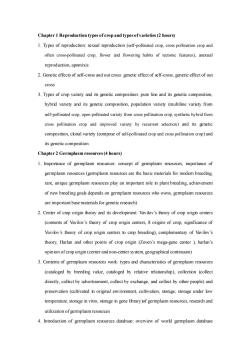
Chapter1 Reproduction types ofcropand typesofvarieties (2 hours)1.Types of reproduction: sexual reproduction (self-pollinated crop, cross pollination crop andoften cross-pollinated crop,flower and flowering habits of tectonic features),asexualreproduction,apomixis2. Genetic effects of self-cross and out cross: genetic effect of self-cross,genetic effectof outcross3.Types of crop variety and its genetic composition:pure line and its genetic composition,hybrid variety and its genetic composition, population variety (multiline variety fromself-pollinated crop, open pollinated variety from cross pollination crop, synthetic hybrid fromcross pollination crop and improved variety by recurrent selection) and its geneticcomposition,clonalvariety(composeofself-pollinatedcropandcrosspollinationcrop)andits geneticcompositionChapter 2 Germplasm resources (4 hours)1.Importanceof germplasm resources:conceptof gemplasm resources,importance ofgermplasm resources (gemplasm resources are the basic materials for modem breeding,rare,unique germplasm resources playan importantrole in plant breeding,achievementof new breeding goals depends on germplasm resources who owns, gemplasm resourcesare important base materials for genetic research)2. Center of crop origin theory and its development: Vavilov's theory of crop origin centers(contents of Vavilov's theory of crop origin centers, 8 origins of crop, significance ofVavilov's theory of crop origin centers to crop breeding), complementary of Vavilov'stheory, Harlan and other points of crop origin (Zeven's mega-gene center ), harlan'sopinionofcroporigin (centerandnon-centersystem,geographical continuum)3.Contentsof germplasmresources work:typesand characteristics ofgermplasmresources(cataloged by breeding value,cataloged by relative relationship),collection (collectdirectly, collect by advertisement, collect by exchange, and collect by other people) andpreservation (cultivated in original environment, cultivation, storage, storage under lowtemperature, storage in vitro, storage in gene library)of germplasm resources, research andutilizationofgermplasmresources4. Introduction of germplasm resources database: overview of world germplasm database
Chapter 1 Reproduction types of crop and types of varieties (2 hours) 1. Types of reproduction: sexual reproduction (self-pollinated crop, cross pollination crop and often cross-pollinated crop, flower and flowering habits of tectonic features), asexual reproduction, apomixis 2. Genetic effects of self-cross and out cross: genetic effect of self-cross, genetic effect of out cross 3. Types of crop variety and its genetic composition: pure line and its genetic composition, hybrid variety and its genetic composition, population variety (multiline variety from self-pollinated crop, open pollinated variety from cross pollination crop, synthetic hybrid from cross pollination crop and improved variety by recurrent selection) and its genetic composition, clonal variety (compose of self-pollinated crop and cross pollination crop) and its genetic composition Chapter 2 Germplasm resources (4 hours) 1. Importance of germplasm resources: concept of germplasm resources, importance of germplasm resources (germplasm resources are the basic materials for modern breeding, rare, unique germplasm resources play an important role in plant breeding, achievement of new breeding goals depends on germplasm resources who owns, germplasm resources are important base materials for genetic research) 2. Center of crop origin theory and its development: Vavilov’s theory of crop origin centers (contents of Vavilov’s theory of crop origin centers, 8 origins of crop, significance of Vavilov’s theory of crop origin centers to crop breeding), complementary of Vavilov’s theory, Harlan and other points of crop origin (Zeven’s mega-gene center ), harlan’s opinion of crop origin (center and non-center system, geographical continuum) 3. Contents of germplasm resources work: types and characteristics of germplasm resources (cataloged by breeding value, cataloged by relative relationship), collection (collect directly, collect by advertisement, collect by exchange, and collect by other people) and preservation (cultivated in original environment, cultivation, storage, storage under low temperature, storage in vitro, storage in gene library)of germplasm resources, research and utilization of germplasm resources 4. Introduction of germplasm resources database: overview of world germplasm database
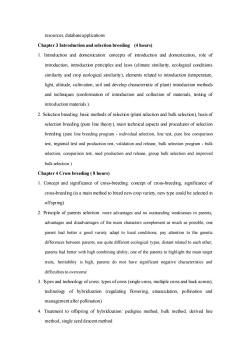
resources,databaseapplicationsChapter3 Introduction and selectionbreeding(4hours)1:Introduction and domestication:concepts of introduction and domestication, role ofintroduction, introduction principles and laws (climate similarity, ecological conditionssimilarity and crop ecological similarity), elements related to introduction (temperature,light,altitude,cultivation,soiland developcharacteristic of plant)introductionmethodsand techniques (conformation of introduction and collection of materials,testing ofintroduction materials ).2. Selection breeding: basic methods of selection (plant selection and bulk selection), basis ofselection breeding (pure line theory), main technical aspects and procedures of selectionbreeding (pure line breeding program - individual selection, line test, pure line comparisontest, regional test and production test, validation and release, bulk selection program - bulkselection, comparison test, seed production and release, group bulk selection and improvedbulk selection.)Chapter4Crossbreeding(8hours)1. Concept and significance of cross-breeding: concept of cross-breeding, significance ofcross-breeding (isa mainmethod to breed newcropvariety,new typecould be selected inoffspring)2. Principle of parents selection: more advantages and no outstanding weaknesses in parents,advantages and disadvantages of the main characters complement as much as possible; oneparent had better a good variety adapt to local conditions, pay attention to the geneticdifferences between parents, use quite different ecological types, distant related to each otherparents had better with high combining ability, one of the parents to highlight the main targettraits, heritability is high, parents do mot have significant negative characteristics anddifficulties to overcome3.Typesandtechnologyofcross:typesofcross(singlecross,multiplecrossandbackacross)technology of hybridization (regulating flowering, emasculation,pollination andmanagement after pollination)4. Treatment to offspring of hybridization: pedigree method, bulk method, derived linemethod, single seed descent method
resources, database applications Chapter 3 Introduction and selection breeding (4 hours) 1. Introduction and domestication: concepts of introduction and domestication, role of introduction, introduction principles and laws (climate similarity, ecological conditions similarity and crop ecological similarity), elements related to introduction (temperature, light, altitude, cultivation, soil and develop characteristic of plant) introduction methods and techniques (conformation of introduction and collection of materials, testing of introduction materials ). 2. Selection breeding: basic methods of selection (plant selection and bulk selection), basis of selection breeding (pure line theory), main technical aspects and procedures of selection breeding (pure line breeding program - individual selection, line test, pure line comparison test, regional test and production test, validation and release, bulk selection program - bulk selection, comparison test, seed production and release, group bulk selection and improved bulk selection.) Chapter 4 Cross breeding ( 8 hours) 1. Concept and significance of cross-breeding: concept of cross-breeding, significance of cross-breeding (is a main method to breed new crop variety, new type could be selected in offspring) 2. Principle of parents selection: more advantages and no outstanding weaknesses in parents, advantages and disadvantages of the main characters complement as much as possible; one parent had better a good variety adapt to local conditions, pay attention to the genetic differences between parents, use quite different ecological types, distant related to each other; parents had better with high combining ability; one of the parents to highlight the main target traits, heritability is high, parents do mot have significant negative characteristics and difficultiesto overcome 3. Types and technology of cross: types of cross (single cross, multiple cross and back across), technology of hybridization (regulating flowering, emasculation, pollination and management after pollination) 4. Treatment to offspring of hybridization: pedigree method, bulk method, derived line method, single seed descent method
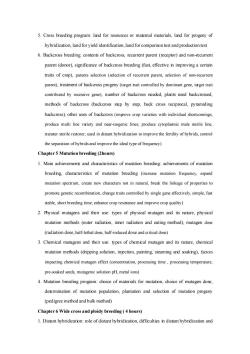
5.Crossbreedingprogram:land for resources or matemal materials,land forprogenyofhybridization,land for yield identification,land for comparisontestand productiontest6.Backcrossbreeding:contentsof backcross,recurrentparent(receptor)andnon-recurrentparent (donor), significance of backcross breeding (fast, effective in improving a certaintraits of crop),parents selection (selection of recurrent parent, selection of non-recurrentparent), treatment of backcross progeny (target trait controlled by dominant gene, target traitcontributed by recessive gene), number of backcross needed, plants need backcrossed,methods of backcross (backcross step by step,back cross reciprocal,pyramidingbackcross), other uses of backcross (improve crop varieties with individual shortcomings;produce multi line variety and near-isogenic lines; produce cytoplasmic male sterile line,transter sterile restorer, used in distant hybridization to improve the fertility of hybrids, controlthe separation of hybrids and improve the ideal type of frequency)Chapter5Mutationbreeding (2hours)1. Main achievements and characteristics of mutation breeding. achievements of mutationbreeding. characteristics of mutation breeding (increase mutation frequency, espandmutation spectrum, create new characters not in natural, break the linkage of properties topromotegenetic recombination,changetraits controlledby singlegene effectively,simple,faststable, short breeding time, enhance crop resistance and improve crop quality)2. Physical mutagens and their use: types of physical mutagen and its nature, physicalmutation methods (outer radiation, inner radiation and eating method), mutagen dose(radiation dose, half-lethal dose, half-induced dose and critical dose)3. Chemical mutagens and their use: types of chemical mutagen and its nature, chemicalmutation methods (dripping solution, injection, painting, steaming and soaking), factorsimpacting chemical mutagen effect (concentration, processing time,processing temperature,pre-soaked seeds, mutagenic solution pH, metal ions)4. Mutation breeding program: choice of materials for mutation, choice of mutagen dose,determination of mutation population, plantation and selection of mutation progeny(pedigreemethodandbulk method)Chapter6 Wide cross and ploidy breeding (4 hours)1.Distant hybridization:roleof distanthybridization,difficulties indistanthybridization and
5. Cross breeding program: land for resources or maternal materials, land for progeny of hybridization, land for yield identification, land for comparison test and production test 6. Backcross breeding: contents of backcross, recurrent parent (receptor) and non-recurrent parent (donor), significance of backcross breeding (fast, effective in improving a certain traits of crop), parents selection (selection of recurrent parent, selection of non-recurrent parent), treatment of backcross progeny (target trait controlled by dominant gene, target trait contributed by recessive gene), number of backcross needed, plants need backcrossed, methods of backcross (backcross step by step, back cross reciprocal, pyramiding backcross), other uses of backcross (improve crop varieties with individual shortcomings; produce multi line variety and near-isogenic lines; produce cytoplasmic male sterile line, transter sterile restorer; used in distant hybridization to improve the fertility of hybrids, control the separation of hybrids and improve the ideal type of frequency) Chapter 5 Mutation breeding (2hours) 1. Main achievements and characteristics of mutation breeding: achievements of mutation breeding, characteristics of mutation breeding (increase mutation frequency, espand mutation spectrum, create new characters not in natural, break the linkage of properties to promote genetic recombination, change traits controlled by single gene effectively, simple, fast stable, short breeding time; enhance crop resistance and improve crop quality) 2. Physical mutagens and their use: types of physical mutagen and its nature, physical mutation methods (outer radiation, inner radiation and eating method), mutagen dose (radiation dose, half-lethal dose, half-induced dose and critical dose) 3. Chemical mutagens and their use: types of chemical mutagen and its nature, chemical mutation methods (dripping solution, injection, painting, steaming and soaking), factors impacting chemical mutagen effect (concentration, processing time , processing temperature, pre-soaked seeds, mutagenic solution pH, metal ions) 4. Mutation breeding program: choice of materials for mutation, choice of mutagen dose, determination of mutation population, plantation and selection of mutation progeny (pedigree method and bulk method) Chapter 6 Wide cross and ploidy breeding ( 4 hours) 1. Distant hybridization: role of distant hybridization, difficulties in distant hybridization and
按次数下载不扣除下载券;
注册用户24小时内重复下载只扣除一次;
顺序:VIP每日次数-->可用次数-->下载券;
- 《植物育种学》课程教学大纲(植物育种原理教学大纲,中英文).doc
- 《植物营养学》课程教学资源(PPT课件)第七章 养分的吸收.ppt
- 《植物营养学》课程教学资源(PPT课件)第五章 有益元素.ppt
- 《植物营养学》课程教学资源(PPT课件)第十一章 植物对逆境土壤的适应性.ppt
- 《植物营养学》课程教学资源(PPT课件)第十章 植物营养的遗传特性与改良.ppt
- 《植物营养学》课程教学资源(PPT课件)第九章 矿质营养与植物生长、产量和品质的关系.ppt
- 《植物营养学》课程教学资源(PPT课件)第八章 养分的运输和分配.ppt
- 《植物营养学》课程教学资源(PPT课件)第六章 土壤养分生物有效性.ppt
- 《植物营养学》课程教学资源(PPT课件)第四章 微量营养元素 4.2 硼 B.ppt
- 《植物营养学》课程教学资源(PPT课件)第四章 微量营养元素 4.6 钼 Mo.ppt
- 《植物营养学》课程教学资源(PPT课件)第四章 微量营养元素 4.8 镍 Ni.ppt
- 《植物营养学》课程教学资源(PPT课件)第四章 微量营养元素 4.4 铜 Cu.ppt
- 《植物营养学》课程教学资源(PPT课件)第四章 微量营养元素 4.7 氯 Cl.ppt
- 《植物营养学》课程教学资源(PPT课件)第四章 微量营养元素 4.5 锌 Zn.ppt
- 《植物营养学》课程教学资源(PPT课件)第四章 微量营养元素 4.3 锰 Mn.ppt
- 《植物营养学》课程教学资源(PPT课件)第二章 营养元素的生理功能 2.1 氮 N.ppt
- 《植物营养学》课程教学资源(PPT课件)第四章 微量营养元素 4.1 铁 Fe.ppt
- 《植物营养学》课程教学资源(PPT课件)第一章 绪论.ppt
- 《植物营养学》课程教学资源(PPT课件)第三章 中量营养元素 3.3 硫 S.ppt
- 《植物营养学》课程教学资源(PPT课件)第三章 中量营养元素 3.2 镁 Mg.ppt
- 《植物育种学》课程教学资源(授课教案)第二章 种质资源.doc
- 《植物育种学》课程教学资源(授课教案)第三章 育种目标.doc
- 《植物育种学》课程教学资源(授课教案)绪论.doc
- 《植物育种学》课程教学资源(授课教案)第一章 作物繁殖方式与品种类型.doc
- 《植物育种学》课程教学资源(授课教案)第七章 诱变育种.doc
- 《植物育种学》课程教学资源(授课教案)第六章 回交育种.doc
- 《植物育种学》课程教学资源(授课教案)第五章 杂交育种.doc
- 《植物育种学》课程教学资源(授课教案)第四章 引种与选择育种.doc
- 《植物育种学》课程教学资源(授课教案)第七章 诱变育种(种科专业).doc
- 《植物育种学》课程教学资源(授课教案)第八章 远缘杂交育种.doc
- 《植物育种学》课程教学课件(PPT讲稿)第三章 种质资源 第一节 种质资源工作的重要性.ppt
- 《植物育种学》课程教学课件(PPT讲稿)第一章 作物繁殖方式及品种类型.ppt
- 《植物育种学》课程教学课件(PPT讲稿)第二章 育种目标.ppt
- 《植物育种学》课程教学课件(PPT讲稿)第三章 种质资源 第二节 作物起源中心学说.ppt
- 《植物育种学》课程教学课件(PPT讲稿)第四章 引种和选择育种.ppt
- 《植物育种学》课程教学课件(PPT讲稿)第五章 杂交育种 第一节 杂交育种的意义 第二节 杂交亲本的选配 第三节 杂交技术与杂交方式.ppt
- 《植物育种学》课程教学课件(PPT讲稿)绪论.ppt
- 《植物育种学》课程教学课件(PPT讲稿)第六章 回交育种.ppt
- 《植物育种学》课程教学课件(PPT讲稿)第五章 杂交育种 第四节 杂种后代的选择.ppt
- 《植物育种学》课程教学课件(PPT讲稿)第七章 诱变育种 Mutation Breeding.ppt
